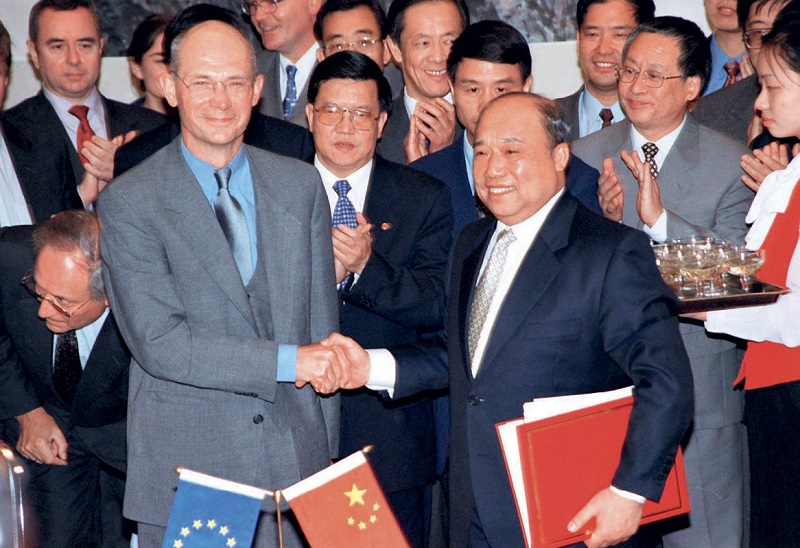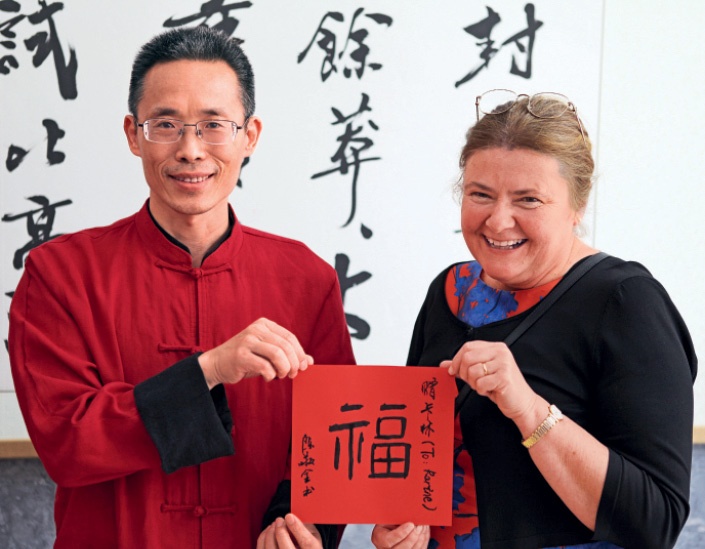Marking 50 years of diplomatic ties, the EU-China relationship navigates complex dynamics as the EU balances partnership and competition, amidst shifting transatlantic landscapes.

After five days of mutually respectful and friendly negotiations, the Chinese and EU delegations finally reach a bilateral agreement on China’s accession to the World Trade Organization on May 19, 2000. After signing the agreement, EU Trade Commissioner Pascal Lamy and Chinese Minister of Foreign Trade and Economic Cooperation Shi Guangsheng shake hands to congratulate each other.
China and the predecessor of the European Union (EU), the European Economic Community (EEC), established diplomatic relations in 1975. This year marks the 50th anniversary of that historic milestone, at a time when the development of bilateral relations is facing major challenges and opportunities. These 50 years reflect a long-standing relationship that has fostered greater mutual understanding and knowledge. This shared history has made it possible for the two sides to overcome highs and lows and approach misunderstandings constructively.
Throughout this journey, both sides have developed in largely parallel ways. In 1975, the EEC was laying the foundations for the influence it would exert over the following decades; likewise, China, which was shedding the final remnants of the Cultural Revolution, was charting the course of its reform and opening-up policy, which would drive the well-known expansion of its economy. As a result of those decisions, both the EU and China emerged on the international stage as major players, whose involvement is essential in addressing the key issues of global society.
It is also worth noting that, during this time, one principal trend stands out: the general affirmation of mutual respect and dialogue, and the effort to reach fair and mutually beneficial agreements.

In Brussels, Belgium, the Chinese Mission to the EU holds an award ceremony for a creative competition under the theme of “Reviewing the 50-Year Journey of China-EU Relations, Joining Hands to Embrace a Shared Future” on April 28, 2025. The event celebrated the 50th anniversary of China-EU diplomatic relations through friendly and creative works. In the photo, a staff member presents the Chinese character of “Fu” (good fortune) to guests at the calligraphy appreciation booth.
Figures Tell the Story
China and the EU are major trading partners. Over the past 50 years, the value of bilateral trade has grown from US $2.4 billion in the early years to US $780 billion today – a 325-fold increase. According to Chinese customs data, in the first quarter of 2025, the value of trade between the two sides reached RMB 1.3 trillion, a year-on-year increase of 1.4 percent.
These figures speak for themselves. China and the EU are the world’s second and third largest economies, representing more than a third of the global economy and a quarter of global trade. Their relationship is characterized by deep interdependence and highly satisfactory complementarity. But perhaps most notable – especially in the current context – is their shared defense of core principles now under scrutiny: inclusive globalization, multilateralism, free trade, and the central role of the World Trade Organization. These are essential foundations for further progress in their relationship and for responding to today’s challenges.
This is despite the fact that in recent years, the EU has defined China not only as a partner but also as a competitor and “systemic rival.” Certain frictions have emerged in their relationship. Three main factors can be identified to explain this shift.
First, we are in the midst of a new wave of industrial and technological revolution, which poses major challenges for all, especially against the backdrop of a deepening climate crisis that severely impacts the future of humanity. Second, there is a systemic disparity: while China’s political model allows for quick and effective decision-making and implementation, the EU’s political process continues to suffer from limitations that hinder bold action at a time when agility is needed. The old dilemma posed by the late Secretary of State Henry Kissinger of, “Who do I call if I want to speak to Europe?” – remains unresolved. This has led to misunderstandings with Beijing, for example, when China advances bilateral relations with specific EU countries or establishes sub-regional forums with Central and Eastern European countries, which is often seen as an attempt to fragment the EU, even though it actually reflects the differing pace of European integration.
Finally, strategic circumstances must be considered. In the current context, the breakdown threatening transatlantic relations poses significant dilemmas that generate a degree of anxiety within the EU.
Against this backdrop, China and the EU need more dialogue, more coordination, and more communication in order to build greater trust.

Container loading operations are underway for the China-Europe Railway Express at a port in Jinhua City of east China’s Zhejiang Province on May 3, 2025.
Spain’s Role
In April of this year, Spanish Prime Minister Pedro Sánchez made his third visit to China in three years, becoming the first EU head of government to visit Beijing following U.S. President Donald Trump’s announcement of global tariffs.
This shift in the international script has highlighted a relevant fact: today, the EU – largely unanimously dissatisfied with the tariff hikes – shares many more key positions with China than with the United States. Even in matters like the pursuit of peace in Ukraine, where China supports a role for the EU that the U.S. disregards. We are thus on the verge of a possible paradigm shift that could lead to greater understanding between China and the EU, further alignment, and, hopefully, a deeper bilateral dialogue to revitalize the foundations of global economic governance. All of this unfolds despite Washington’s sustained efforts to pressure the EU into adopting its strategy to contain China.
Spain is China’s fifth-largest trading partner within the EU. Bilateral trade exceeded US $50 billion in 2024, with significant investments underway, and following Prime Minister Sánchez’s recent visit, a notable increase in Spanish exports is expected.
Spanish public opinion is predominantly pro-European and favors strengthened ties with China. The Spanish government believes there is room to address shared challenges – such as climate change and poverty – and advocates for this rapprochement within the EU. Additionally, Spain brings an element of interest: its influence in the Global South, acting as a bridge to the Western world.
China and the EU agree in their rejection of unilateralism, protectionism, and economic hegemonism. They are also committed to the stability of supply and industrial chains and to global systemic stability. Both sides share principles, have common interests, and have aligned priorities. The differences that do exist serve as an incentive for a negotiation culture, anchored in deep-rooted and mutually respected traditions upheld by both parties.
A Shared Future
Cooperation between China and the EU carries significant strategic weight. This is because both are capable of greatly influencing the direction of the global agenda.
In a context of high volatility and uncertainty, managing the relationship with China is the ultimate test of the EU’s real strategic autonomy. The crisis or potential breakdown of the transatlantic order invites the EU to rethink its relationship with China based on its own interests. If the EU aspires to be a truly global player, only a renewed relationship with China can provide that added strategic value. It can also provide the stability increasingly threatened internally by the rise of extremism, which is reviving ghosts of a past we believed long overcome. 
XULIO RÍOS is an emeritus advisor at the Chinese Policy Observatory of Spain.